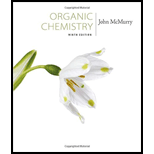
Interpretation:
The observation that a compound having a cyclobutane ring fused to a five membered ring is heated, [1Z,3Z]-1,3-cycloheptadiene is formed while a compound having a cyclobutane ring fused to an eight membered ring is heated, [1E,3Z]-1,3-cyclodecadiene is formed is to be explained. Further why opening of the eight membered ring occurs at low temperature is to be explained.
Concept introduction:
An electrocyclic reaction involves the cyclization of a conjugated acyclic system. These reactions are reversible and are highly stereospecific.
In elecrocyclic reactions involving even number of electron pairs, a thermal reaction occurs in conrotatory manner and a photochemical reaction occurs in disrotatory manner.
In elecrocyclic reactions involving odd number of electron pairs, a thermal reaction occurs in disrotatory manner and a photochemical reaction occurs in conrotatory manner.
Want to see the full answer?
Check out a sample textbook solution
Chapter 30 Solutions
Study Guide with Student Solutions Manual for McMurry's Organic Chemistry, 9th
- The reaction Q(g) + R(g) → Z(l) is shown to be exothermic. Which of the following is true concerning the reactionarrow_forwardWhich of the following has the largest standard molar entropy, S° (298.15 K) He H2 NaCl KBr Hgarrow_forwardWhich of the following is true for a particular reaction if ∆G° is -40.0 kJ/mol at 290 K and –20.0 kJ/mol at 390 K?arrow_forward
- Choose the major product of the reaction with correct regio- and stereochemistry. Br2 H₂O O "Br Br & O 'Br OH Br 吡 O OH OH Br "OH Brarrow_forwardSelect the major product of the following reaction. & Br (CH)CONa (CH₂),COH 0 OC(CH) O &arrow_forwardDraw the products of the hydrolysis reaction between the ester molecule and water. Determine the products of the following reaction.arrow_forward

 Organic ChemistryChemistryISBN:9781305580350Author:William H. Brown, Brent L. Iverson, Eric Anslyn, Christopher S. FootePublisher:Cengage Learning
Organic ChemistryChemistryISBN:9781305580350Author:William H. Brown, Brent L. Iverson, Eric Anslyn, Christopher S. FootePublisher:Cengage Learning

